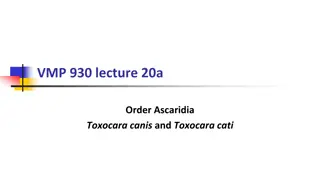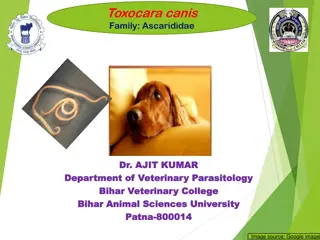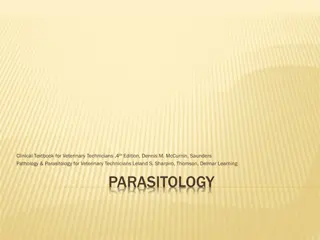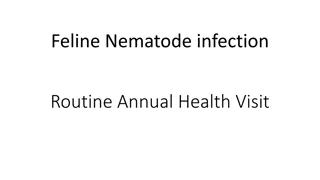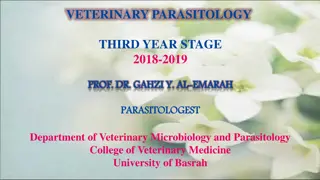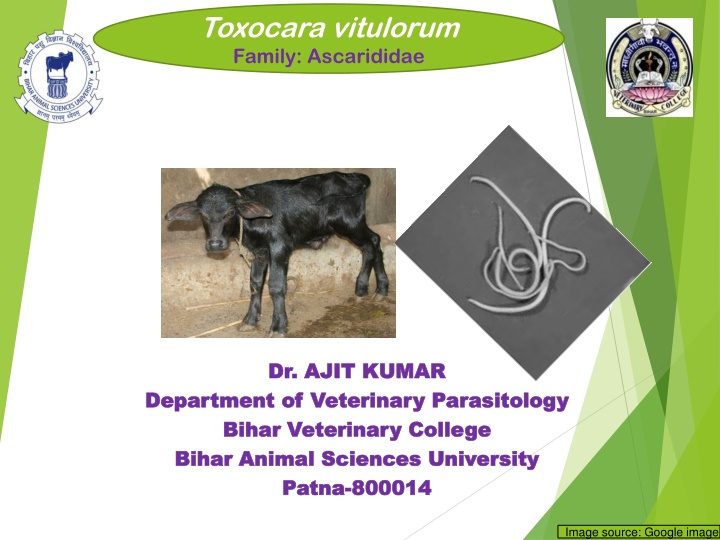
Toxocara vitulorum: Lifecycle, Pathogenesis & Clinical Signs
Learn about Toxocara vitulorum, a nematode affecting cattle & buffalo, including its lifecycle, transmission, pathogenesis, clinical signs, and impact on calves. Explore the risks, symptoms, and management strategies associated with this parasitic infection.
Download Presentation

Please find below an Image/Link to download the presentation.
The content on the website is provided AS IS for your information and personal use only. It may not be sold, licensed, or shared on other websites without obtaining consent from the author. If you encounter any issues during the download, it is possible that the publisher has removed the file from their server.
You are allowed to download the files provided on this website for personal or commercial use, subject to the condition that they are used lawfully. All files are the property of their respective owners.
The content on the website is provided AS IS for your information and personal use only. It may not be sold, licensed, or shared on other websites without obtaining consent from the author.
E N D
Presentation Transcript
Toxocara vitulorum Family: Ascarididae Bihar Animal Sciences University | Dr. AJIT KUMAR Dr. AJIT KUMAR Department of Veterinary Parasitology Department of Veterinary Parasitology Bihar Veterinary College Bihar Veterinary College Bihar Animal Sciences University Bihar Animal Sciences University Patna Patna- -800014 800014 Image source: Google image
Toxocara viotulorum o Final Host/ Host: Cattle & buffalo o Predilection site: Small Intestine o Largest nematode of Cattle & Buffalo.
Toxocara viotulorum General Characters: o Male are 25 cm whereas Females are about 30 cm long o Body of worm is soft and cuticle is translucent. So, the internal organs can be seen o Extremities narrow. are not so o Eggs shaped, thick finely pitted shell. are colourless subglobular with
Toxocara virulorum Life Life- -cycle cycle: : o Direct life-cycle o Infective containing 2nd stage larvae. stage: egg Transmission vitulorum following route: : Toxocara occurs transmission 1. 1. Oral Oral or egg egg containing containing L L2 2 or ingestion ingestion of of infective infective 2.Transmammary Transmammary / / transcolostral transmission transmission transcolostral
Toxocara virulorum Life Life- -cycle cycle: : Transmammary constitute the major sources of T. vitulorum infection for calves. Ingestion of infective eggs containing L2 calves or adult does not lead to patent infection. Instead hatched out L2 stage reaches various /tissues and remain dormant. Larvae start mobilizing and migrating glands during late pregnancy period. Just after parturition, the migrating larvae are shed in milk and transmammary transmission up to 3-4 weeks. Calves, soon after birth, feed on colostrums and the larvae grow to adult worms in their intestine in four weeks. infections o o larvae by o organs to mammary lead to o approximately
Toxocara viotulorum Pathogenesis: Worms are highly pathogenic in calves ( especially buffalo calves) below 6 months of age. Partial or complete obstruction of the lumen of gut. Digestive disturbances Anaemia o o Patent period is short and natural expulsion of adult worms starts as early as 38 days after birth and by 4-6 months no adult worms remain. o o Intestinal Obstruction
Toxocara vitulorum Clinical signs: Worms produces steatorrhoea, colic, mud-coloured smelling faeces, obstruction in case of large number of worms, pot-belly, poor boat coat, emacition and death. foul intestinal
Toxocara vitulorum Diagnosis : o On the basis of Clinical signs o Gross examination of faeces o Microscopic faecal examination Each female worm produces about 8 106 eggs/day.
Toxocara vitulorum Treatment o Pyrantel pamoate ( 250 mg/kg body wt. orally), Piperazine, Fenbendazole, Levamisole used in the treatment. etc. are
Toxocara vitulorum Control : Toxocara vitulorum infection can be controlled by regular deworming with suitable anthelmintic. In case of calves deworming will be started at the age of 10- 15 days and then after every months up to 6 months of age. Regular disposal of faeces, separate rearing of adult and young animals etc..
THANK YOU

